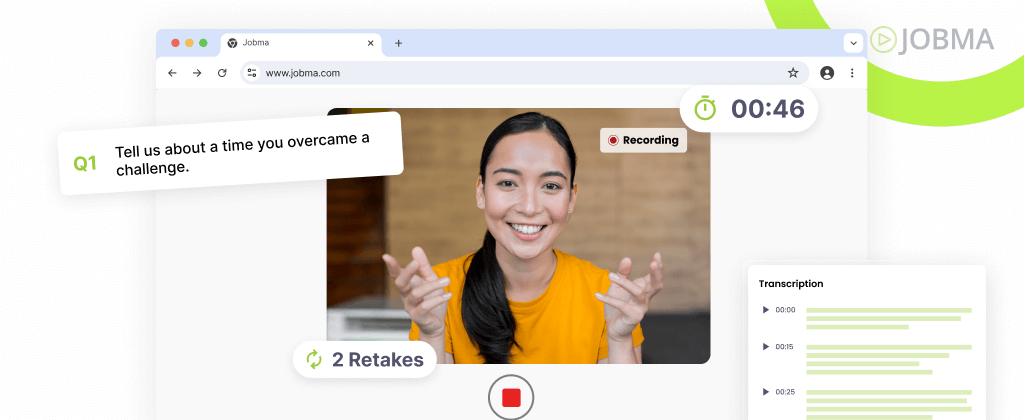The Recruiter’s Guide to One-Way, Asynchronous Interviews
Hiring teams are constantly balancing high candidate volumes, resource constraints, and the need to move quickly. But it’s not just about screening faster. It’s about elevating the entire hiring experience with a more modern, adaptable, and candidate-friendly approach that meets the pace of evolving talent expectations.
The early stages of hiring often come with risks of inefficiencies. You’re reaching out to large volumes of candidates without knowing who’s truly a good fit. Countless hours are spent coordinating calendars, chasing responses, and scheduling interviews, only to find that many candidates do not meet the basic requirements. This not only strains limited resources but also adds unnecessary delays to your hiring pipeline. Different interviewers ask different questions, use varied evaluation styles, and have minimal structure during initial interactions. The lack of standardization leads to subjectivity, inefficiency, and in some cases, poor hiring decisions.

That’s why modern hiring teams are turning to tools that cut through the noise and bring structure upfront. One-way interviews offer a way to streamline this chaos by letting candidates respond to standardized questions on their own time, removing bottlenecks, reducing repetitive manual work, building hiring systems that are more structured, scalable, and ultimately more human, and allowing recruiters to focus on evaluating quality.
In this blog, we’ll explore whether these interviews can enable smarter hiring decisions, make workflows more efficient, and help teams stay competitive in today’s fast-moving talent landscape.
What is a One-way Video Interview?
A one-way interview (also called an asynchronous interview or pre-recorded interview) allows candidates to record responses to pre-determined questions without needing a live interviewer. Think of it as a scalable, structured interview.

Instead of juggling calendars, you can send a single link and let candidates record their answers at their convenience. These video responses can be replayed, allowing you to review, pause, rewind, and even compare candidates side-by-side.
- No need to align calendars or chase schedules.
- Review responses anytime, at your pace.
- Share recordings with stakeholders and decision-makers without repeating interview rounds.
- Evaluate every candidate on the standardized role-specific criteria.
- Remove the risks of unconscious bias affecting candidate evaluation.
According to SHRM, 74% of recruiters have found that video interviews have made it easier to interview and shortlist candidates. This format is especially helpful for high-volume roles or first-contact screening rounds where recruiters need structure and speed. It also supports collaboration across teams and time zones, giving you and your hiring team a unified view of each candidate early in the process. With next-gen AI-powered video interviewing tools, recruiters can create, conduct, and manage one-way interviews seamlessly, ensuring that screening becomes a strategic asset, not a bottleneck.
Why Modern Hiring Teams are Embracing Asynchronous Interviews
Modern hiring teams are turning to asynchronous interviews to save time, reduce scheduling hassles, and create a consistent screening experience at scale.
Eliminate Scheduling Hassles
Candidates can complete these interviews on their own time, and recruiters can review responses asynchronously. This removes the need to coordinate calendars. Instead of spending 20-30 minutes per candidate on screening calls, recruiters can view video responses and rate interviews quickly and efficiently. This not only reduces administrative burden but also allows teams to focus more on candidate quality. The time saved can be reallocated to more strategic recruitment activities like employer branding or improving candidate experience.
Standardize the Evaluation Process
Every candidate receives the same set of questions, which they need to respond to in the same format. This eliminates variability and unconscious bias while enabling structured evaluation. Using a standardized format ensures fairness across all candidate submissions. Recruiters can use common rating criteria and pre-set score metrics, like rubrics or skill-based star ratings, to evaluate responses. This consistency is especially important for distributed teams where multiple stakeholders are involved in the evaluation process.
Improve Speed and Quality of Screening
One-way interviews accelerate the hiring process by removing redundant early rounds to gather basic candidate details like qualifications, skills, and professional experience. You can quickly identify unqualified candidates, letting only the best move forward. By reviewing recorded responses to standardized questions, recruiters can identify red flags, evaluate the clarity of thought, and compare how candidates articulate their skills. With these interviews, you can review 3-4 candidate responses in the time it would take to complete one phone screen. This allows hiring teams to concentrate their live interactions on higher-quality candidates, leading to better conversion and lower interview drop-off rates.
Expand Global Reach
Traditional interviews can limit you to the local talent pool because of difficulties in coordinating over calls and live interviews across time zones. Asynchronous interviews make it possible to build a globally distributed workforce. It empowers your team to assess candidates from different countries, regions, and geographies and find the right fit from anywhere in the world. For example, if you’re hiring for a support role in Asia while based in the US, candidates can complete their interviews in their timezone without having to find a common time that suits you both. Your team can review them during their work hours, creating a truly asynchronous yet effective hiring pipeline.
Enable Collaborative Hiring
Hiring managers don’t need to be present live during every candidate-interviewer interaction, they can review responses when convenient, leave feedback and ratings, and participate more actively in selection without hindering strategic work. Involving multiple stakeholders in early-stage screening becomes more manageable when interviews are recorded. Hiring managers can watch specific responses, compare candidates side-by-side, and leave timestamped feedback. This not only improves transparency and alignment across the team but also ensures that decisions are well-rounded and data-driven.
How to Conduct One-Way Video Interviews
Here’s our step-by-step guide you can follow to create your effective one-way video interview process.
By weaving in elements like natural light, greenery, soothing decor, and calming water features, companies can create a workspace that boosts productivity and creativity. Invest in a space that inspires your team, and you’ll see that energy reflected in their work and your company’s results.
Step 1: Define Your Hiring Goals
Before anything else, clarify what you’re trying to evaluate. Are you screening for communication skills, technical capabilities, adaptability, or cultural alignment? For instance, a customer-facing role may require strong articulation and empathy, whereas a backend developer role may prioritize technical clarity and problem-solving. Document these expectations so every question you include has a purpose.
Step 2: Craft the Right Questions
Design 3-5 role-relevant questions that mirror real job challenges. For example:
- “Describe a time you had to work under pressure. What was your approach to tackling it?”
- “How would you approach solving a client complaint that’s escalated to your desk?”
Each question should help you assess a core competency. Avoid vague prompts like “Tell us about yourself.” Instead, ask targeted questions that reflect everyday scenarios in the role.
If you’re unsure how to phrase your questions or want to ensure they align with the role’s competencies, use AI-powered interviewing management systems, like Jobma, that can generate or refine question sets based on job descriptions, skill tags, or industry benchmarks, and more. This can help streamline the process while maintaining relevance and objectivity.
Step 3: Decide on Format and Flow
Define the structure clearly with prep time, answer time, and total interview time separately defined to balance candidate comfort with recruiter efficiency. For entry-level roles, you might keep prep time slightly less to keep energy high and responses natural. And for technical or leadership roles, consider giving slightly more prep time, so candidates can think through complex questions.
For example, a marketing analyst candidate might get 45 seconds to prepare a response to a data interpretation-based question, while a senior project manager might be given 60 seconds to reflect on and quote a past work scenario. Additionally, map the interview structure to job complexity. A high-volume sales role might only need 3 straightforward questions, while a specialized engineering role may benefit from 5 tailored questions.
It’s also helpful to offer a progress indicator, so candidates know how much time they have left for each step.
Step 4: Send Automated Invites
Once your one-way interview is set up, the next step is to communicate with candidates and invite them to complete the interview. This phase is crucial in shaping their perception of your company, so clarity and guidance are non-negotiable. Your interview management system helps ace this by automating invites. Simply provide the contact information of the candidate, and the system can send out an email and SMS notification on your behalf.
Make sure your invitation contains all the things that candidates need to get started:
- Details of the format of the interview: Pre-recorded / One-way video Interview
- Instructions for accessing the interview link
- Any technical requirements (webcam, browser, stable internet)
- The deadline to complete the interview
For example, your message might say: “We’re excited to invite you to the next step in our hiring process, which will be a pre-recorded video interview. You’ll have the opportunity to respond to a few structured questions at your convenience, without the need to schedule a live session. The entire process takes around 15 minutes and is designed to give you flexibility while allowing us to get to know you better.”
Attach or link to a short guide or FAQ page explaining the steps to follow, tips to record in a quiet setting, how many retakes are allowed, and how their responses will be evaluated. This removes uncertainty and boosts participation and confidence.
This thoughtful outreach helps candidates feel supported and informed, even in an asynchronous format, creating a more respectful and human-centered hiring process.
Step 5: Rate and Review Using Smart Evaluation Tools
Once a candidate submits their interview, your hiring stakeholders receive real-time notifications via email and SMS, allowing them to instantly access and begin reviewing the submission at their convenience. This ensures no time is lost and reviews can begin immediately.
Team members can view candidate responses with tools designed for efficient evaluation:
- Add time-stamped comments to specific parts of the video
- Replay answers to analyze consistency and clarity
- Use star ratings (e.g., 1-5) to quickly assess communication, relevance, and job fit
- Refer to AI-generated scores that highlight standout responses or flag weak areas based on predefined parameters
For instance, if a candidate’s response is short and vague, a reviewer might add a comment like “Needs more depth on execution strategy” and assign a 2-star rating. On the other hand, a structured and insightful answer could earn a 5-star with a note like “Strong understanding of customer needs.”
This evaluation format is particularly useful when multiple stakeholders are reviewing asynchronously. Everyone stays aligned with a unified rating system and visibility into each other’s feedback, making hiring decisions more collaborative, structured, and transparent.
Step 6: Communicate What’s Next
Once responses are reviewed, close the loop. Update the candidate’s status, whether they’re selected, rejected, or shortlisted for the next round. Automate updates so candidates get informed as soon as their interview moves to the next stage. Even in asynchronous formats, timely communication creates a professional and human hiring experience.
By following this step-by-step framework, you can build a repeatable, efficient one-way interview process that reduces manual workload, improves consistency, and helps surface the best-fit candidates faster.
Get the Most Out of One-Way Interviews
To get the most out of these interviews, structure is key. Here’s how to build a high-impact interview process:
Ask the Right Questions
Choosing the right interview questions is essential. Focus on situational, skills, or role-specific questions that reveal how a candidate thinks, communicates, and solves problems. Avoid vague or generic questions. Instead, tailor them to provide the most clarity to the candidate and allow them to perform their best.
For example:
- For a customer support role: “Describe a time you dealt with a frustrated customer and how you resolved the issue.“
- For a marketing role: “Walk us through a campaign you led and what made it successful.“
Keep the Interview Duration in Check
Candidates shouldn’t feel overwhelmed by the video interviewing process. So, it’s a good practice to keep total interview time under 15 minutes and limit individual responses to 1-2 minutes per question. This adds structure and ensures candidates don’t drift off-topic or go overboard. The upside? Interviews become manageable and respectful of the candidate’s time.
Lead with Clarity
Provide candidates with a short guide on how the interview works, what they’ll need (e.g., stable internet, webcam, device configuration, etc.), and what to expect. Include practical tips like sitting in a quiet room, using a neutral background, and avoiding reading off a script. You can also suggest light preparation practices, such as outlining key points or using an online grammar checker to refine their responses beforehand, helping them communicate more clearly and confidently on camera. Clarity here reduces candidate anxiety and improves completion rates. Customize the intro page with branded videos or welcome messages to make the process feel more personal.
Prevent Video Fatigue
Watching too many back-to-back interview videos can cause recruiter burnout. Avoid this by scheduling batch reviews. Block dedicated 30-60 minute review slots in your calendar for specific roles or stages. You can also tag priority candidates by adding recommendation notes and comments, or use AI-enabled filters to narrow down high-rated candidates for quicker decision-making. This allows you to stay focused, avoid fatigue, and maintain high-quality evaluations without getting overwhelmed.
Train Your Hiring Teams
Hiring teams need to know what to look for in video responses. Provide a short onboarding session or step-by-step action plan that explains how to evaluate interviews effectively and what criteria to keep in mind. For example, share sales-related skills like persuasion, negotiation, and target management to be evaluated in Sales roles. Or, share customer management-related skills like communication, problem-solving, and empathy to be evaluated in Customer Service roles.
Use example responses to calibrate expectations and discuss what a strong versus weak answer might look like. Allow stakeholders to leave comments directly on interview clips that the whole team can refer to and learn from. This structured, shared learning approach creates alignment and ensures fairer, more consistent decisions across roles.
Power Up Your One-Way Interviews with Jobma
Jobma is purpose-built to help recruiters streamline pre-recorded interviews with greater automation, structure, and insight.

Instead of replacing the recruiter, Jobma augments their capabilities by reducing repetitive tasks, guiding structured interview creation, and enabling more objective candidate evaluations.
- Simplified Interview Setup: Jobma offers customizable templates that you can use to define the flow of your interviews with precision. Features include customizable welcome messages, timed responses for each question, and predefined formats such as video, audio, or text responses. These tools ensure consistency in interviews across different job roles and teams, making it easy to standardize processes while still tailoring the experience to the role’s requirements.
- Frictionless Candidate Experience: Jobma supports browser-based one-way interviews that run on any device without the need for lengthy sign-ups. This simplifies the candidate experience by removing technical setup steps, making interviews more accessible, and minimizing potential delays caused by compatibility issues.
- Ethical AI: Jobma’s objective AI insights support screening by scoring responses based on relevant parameters like communication, role-specific skills, and subject knowledge. These scores serve as directional insights, helping you identify high-potential candidates faster. They act as recommendations that support human decision-making, rather than replace it.
- AI Proctoring: Jobma includes smart AI proctoring features that detect and flag unusual actions like looking outside the screen, the presence of multiple faces, or background noise. These indicators help recruiters maintain integrity and fairness in the process without needing to be present during the interview for monitoring. The flags are marked in the video timeline and can be reviewed at any time, adding an extra layer of transparency to the evaluation process.
- Language Proficiency Tests: For roles, like customer representative and front-desk executive, where communication is key, Jobma supports structured language proficiency assessments within the pre-recorded interview flow. You can add questions with scripts and documents that candidates need to read aloud, describe scenarios, or respond to prompts in specific languages. The AI evaluates pronunciation, grammar, and fluency to help gauge communication skills more objectively, so you can hire for global or client-facing roles with confidence.
- Scalable and Global: Jobma includes scheduling features that automatically adjust for different time zones and offers language support for global regions. These capabilities allow you to create and send one-way interview invites that are accessible across locations, ensuring consistency for candidates regardless of where they are located.
- Integrated With Your Stack: Jobma integrates with commonly used applicant tracking systems (ATS), job boards, and Human Resource Management Systems (HRMS), like Greenhouse, Workday, BambooHR, Checkr, Manatal, etc. This allows evaluation data, candidate statuses, and other workflows to effortlessly sync within your existing hiring technology stack, supporting a smoother data flow between platforms without requiring expensive tech revamps.
Endnotes
A 2024 hiring data report reveals that 69% of employers have already integrated video interviews into their hiring process. As hiring becomes more global, candidate-first, and tech-driven, asynchronous interviews offer scalability without sacrificing personalization. By combining automation, human-first experience design, and smart evaluation tools, Jobma helps you make the one-way interview process more productive and less stressful for both hiring teams and candidates.



